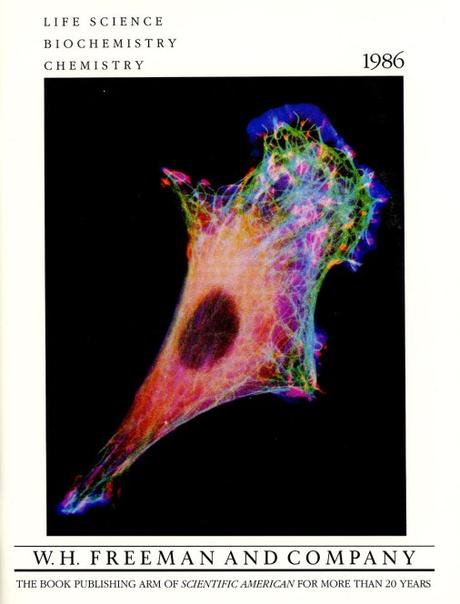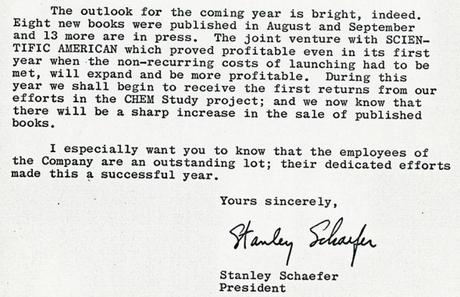
A W.H. Freeman catalog from 1986 noting the firm’s long association with Scientific American magazine.
[Exploring Linus Pauling’s relationship with the W.H. Freeman & Co. publishing firm. Part 5 of 8.]
After more than a decade of success in the publishing world, W. H. Freeman and Co. hit a roadblock. The difficulties began with a personal matter that arose in the summer of 1959, when Bill Freeman separated from his wife, the former Verne Kopplin. When divorce papers were ultimately filed the following year, Freeman offered his wife an even division of all their assets, with the notable exception of his stake in the company. Collectively, the couple owned 43% of the firm and Verne insisted that she retain her share. In her communications with Freeman, Verne pointed out they had married in 1946, the same year that the company was founded, and that they had worked together to grow the company to its current stature. As such, she was entitled to a degree of control over its future direction.
From the outside looking in, Linus Pauling maintained a different point of view. In a letter to Freeman, Pauling expressed his feeling that, although Verne – a prominent Bay Area attorney – had previously provided legal services to Freeman & Co., she had, in his opinion, done little to support the company beyond her contributions as a consultant.
The possibility that Verne might retain a claim to the company was one that weighed heavily on Freeman. In a letter to Pauling he revealed that “I find it quite impossible to carry on my work while sharing with her anything of my future.” He also expressed concern that he might lose control of the company were Verne to retain her shares.
Freeman knew that he would not be able to influence Verne’s decisions concerning the direction of the company. He also feared that she was planning to consolidate the stocks held by colleagues and friends to essentially buy the company out from under him.
Pauling did his best to provide a lift in his reply:
I believe that W.H. Freeman and Company, as built up by you, has become the outstanding publisher of college textbooks of the highest quality in the United States…I was so greatly impressed by your ability that I felt that the advantage of having my book [General Chemistry] put out by your firm, because of your extraordinary ability and originality and convictions about the importance of publication of books of high quality, would outweigh the disadvantage of lack of an organization and reputation of long standing.
He concluded that he wouldn’t feel comfortable continuing his association with the company in the event that Verne succeeded in reducing Freeman’s control over it.
So strong was Pauling’s conviction that he expressed a willingness to dramatically increase his skin in the game. Cognizant of the financial burden that the divorce and its aftermath had placed on Freeman, and hoping to ease this burden, Pauling offered to buy Freeman’s stock, which would provide Freeman with the capital to purchase Verne’s shares should he wish. Freeman agreed to the proposition but only on condition that he be given the option to buy his stock back within three years. Pauling was not comfortable with this arrangement and the two failed to arrive at a solution that would satisfy them both.
In the end Verne retained her shares, and once the divorce was settled in the fall of 1960, Freeman continued to spiral. In order to keep Verne from gaining control of the company, he was obliged to purchase at least 200 of her shares at $55 each while also paying the mortgage on the house that they had shared. In a letter to illustrator Roger Hayward, Freeman bemoaned his state of affairs:
Old man Freeman feels like the tempest in a terribly small teapot; no one ever gives any thought to the tempest’s feelings or understands how constrained he feels.
In need of an escape, Freeman took the summer off to travel around Europe. He made it as far as Greece and self-published a book describing his experiences, titled Ola Kala: The Greek Word for It.

An excerpt from Stanley Schaefer’s letter to shareholders written during trying times for the company that he now led. October 1, 1962.
Meanwhile, tensions mounted at W.H. Freeman & Co. as their eponymous leader became increasingly unstable. A growing sentiment among many stockholders was that Freeman would do anything to keep control. As this idea continued to grain traction, executive vice president Stanley Schaefer became nervous about the future of the company and sent out a request to many of the stockholders that they become proxies, thereby granting them the authority to make decisions about the firm.
Finally, in January 1962, Bill Freeman agreed to sell his stock, though he was resistant to sell within the company because of his objections to the firm’s recent association with Scientific American. It is likely that the arrangement with Scientific American was entered into to provide a measure of protection for the company amidst the financial damage caused by Freeman’s divorce. In his correspondence with Pauling – one of the few people at W.H. Freeman & Co. that he still trusted – Freeman railed against the decision and expressed sharp criticisms of Stanley Schaefer and Bill Kaufman as well as other long-timers like Harvey McCaleb and Adam Kudlacik. Pauling balked at these denunciations, pointing out that Freeman had hand-picked these men and needed to trust in their judgment, as Pauling did.
After a different and particularly troubling discussion with Freeman, who sometimes met the Paulings for dinner, Linus reflected on the current state of the company, noting that “Bill and Verne damaged it, neglected it, and [devoted] their energy to fighting each other.” Though he was sympathetic to Freeman’s situation and deeply concerned about his friend, Pauling believed that there was no justification for the damage that Freeman was causing to the company.
Stanley Schaefer also wanted to help and offered to buy Freeman’s stock. When Freeman declined, Schaefer suggested that Scientific American could purchase the shares. Freeman felt that this was not a realistic solution either. He did, however, agree to not sell his stock to a competing company. When Freeman subsequently took a job at Addison-Wesley’s western office, signing a contract that would allow the company to purchase his Freeman & Co. shares, he effectively broke this promise.
When Pauling asked Freeman why he had done this, Freeman confessed that he was too dissatisfied with the present management at Freeman & Co. to consider associating with it anymore. Scientific American stepped in at this point and made an offer for Freeman’s stock that Addison-Wesley could not match. Ava Helen Pauling, who remained a confidant for Freeman, advised him to sell his stock to the magazine publisher. Doing so, she reasoned, could secure a stable future for his children while also providing an avenue for Freeman to leave his old company gracefully.
Freeman reluctantly agreed and Gerald Piel, the president of Scientific American, put the money from this transaction into a trust fund. Trustees “in whose rationality and integrity” the company had confidence would vote at a later date on the matter of what to do with the proceeds. Meanwhile, once Freeman had become associated with Freeman & Co. in name only, Verne also lost interest and refocused her energies on her legal career. She eventually remarried and went on to challenge discriminatory policies at law firms in Connecticut, where she practiced law for several years.
Some time later, having relocated and newly married to his former secretary, Margaret Cooper, Freeman reached out to Ava Helen to explain his behavior. In his letter, he confided
For old times’ sake, I will say to you that I had no alternatives – financial ones possibly, but professional or personal ones, absolutely none…As I’ve said to Linus, until the future speaks, I trust that we can each of us respect the other’s right to act in accordance with his convictions.
